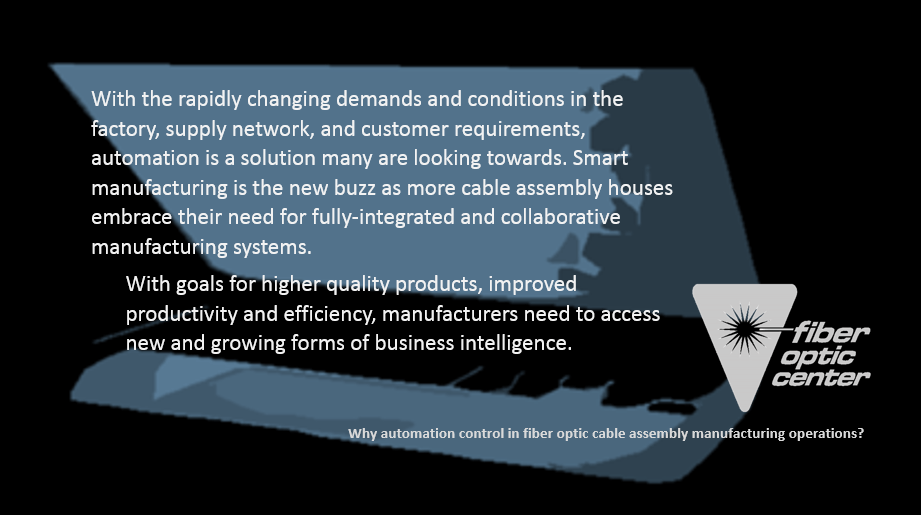With the rapidly changing demands and conditions in the factory, supply network, and customer requirements, automation is a solution many are looking towards. Smart manufacturing is the new buzz as more cable assembly houses embrace their need for fully-integrated and collaborative manufacturing systems.
With goals for higher quality products, improved productivity and efficiency, manufacturers need to access new and growing forms of business intelligence.
What is an “MES” system, and how can it help my fiber optic cable assembly business?
In the world of corporate-acronym-speak, most manufacturers are very familiar with ERP (“Enterprise Resource Planning”) or MRP (“Material Resource Planning”) systems: software packages designed to automate control of various manufacturing operations.
- MRP - MRPs, as the name suggests, tend to focus on improving material supply / logistics: vendor selection, material purchase planning, production planning, scrap control, etc.
- ERP - ERPs tend to a bit more expansive in scope to include other facets of a manufacturing organization, such as finance and sales management, human resource management, etc. They can be very powerful and useful tools for improving business efficiency.
The distinction between ERP and MRP can be a bit blurry, as there can be overlap between the two, but most successful organizations (in my experience) utilize one or the other to some degree to help automate their business management.
Manufacturing Execution Systems (MES)
“Manufacturing Execution Systems” (MES) are also software packages designed to automate management, but (as the name suggests) focus more on the manufacturing process itself: real-time tracking of order details throughout the manufacturing process, including monitoring labor used, product flow, analysis of product test data, etc. Again, there can be overlap between ERP, MRP, and MES systems, but where ERP and MRP systems are primarily the tools of Financial and Material planning in general, MES systems are the tools of Process Engineering.

Labor Costs
When manufacturers consider ways to “automate” their production lines to reduce labor costs, the first consideration is to “automate the equipment” (i.e. automated cable spooling equipment, automated cable strippers, test equipment, etc.). However, the extent to which a production line can be “automated” is limited—there’s always at last SOME direct labor (operators) required, not to mention the significant indirect labor needed to keep the production line running well (supervisors, production managers, engineers, quality inspectors, etc.).
MES systems aim to give you a way to “automate the labor”: collecting the data necessary for support staff to spend more time making informed decisions to improve your product and manufacturing efficiency, and less time on collecting data and making uninformed decisions.
Such software is intended to give you the ability to objectively measure your processes, so that you can effectively measure the effect of improvement efforts and understand the real costs of your manufacturing. All too often, in high-labor-content manufacturing (such as fiber optic cable assembly), the data needed is often difficult to collect (requiring operators to spend time manually recording data, and engineers and managers to spend time organizing, filtering, and interpreting the data).
Data Consolidation
In cases where automated equipment is used (for example, product testing such as interferometer data, or insertion loss data, etc), data can be automatically saved, but often in disparate databases, still requiring much effort to consolidate, filter and organize, and tie to particular product part number or production work orders.
MES systems are not intended to replace your current systems, but to augment them—ideally, being able to easily integrate seamlessly with your existing systems to further improve your manufacturing line performance. As with any such systems, MES software can be a very powerful but flexible tools—what you get out depends on what you put in, or how deeply you choose to integrate into your current systems. Let’s take a look at some potential advantages that MES systems can offer to the typical fiber optic cable assembly production line.
Some advantages an MES system may offer include the abilities to:
- Monitor the status of work-orders as they progress through the manufacturing process.
- Customizable “dashboard” displays give the supervisor/manager an instant view on the status of WIP and identify any lines or processes that are not meeting output plans.
- Trace all raw material lot numbers to individual products.
- A good MES system can integrate with your inventory system to allow for full raw-material lot traceability for each product produced.
- Digitize Process Documentation
- Some MES systems have Documentation functions which allow process documentation (Work Instructions, Visual Aids, Drawings, etc.) to be displayed at each work station, as material comes into that station.
- This can be extremely effective in ensuring manufacturing changes (for example, due to Corrective Action Requests or ECN’s) are effectively implemented.
- Some MES systems have Documentation functions which allow process documentation (Work Instructions, Visual Aids, Drawings, etc.) to be displayed at each work station, as material comes into that station.
- Identify labor cost Actual Labor Costs on a granular level
- Be able to filter actual labor consumption per operation, part number, work order, etc.
- Objectively measure production labor efficiency.
- Compare “actual” labor costs to “planned” labor costs—per operation, part number, work order, etc.
- Consolidate and cross-reference data collected from all steps in the process, in one centralized location.
- Easily match test and inspection data to product families or part numbers, to better identify performance issues which may remain hidden if the data is analyzed in total.
- “Go Paperless” on the production line: obviate the need for paper “work order travelers” or paper data-collection.
- Balance your production line labor: monitor product throughput in every process step, to identify areas where more or less labor resources are required to maintain a steady output.
- Implement true Statistical Process Control on your lines
- Real-time data can be immediately fed back to your production operators, immediately identifying if process control limits are trending in the correct or incorrect direction.
- Supervisors can be immediately alerted to any “problem areas” in any process step, addressing problems before they get out of control.
Conclusion
Effective process engineering improves your production efficiency, and can save significant amount of time and energy. MES systems can help automate your process engineering, ensuring your company’s manufacturing performance metrics are consistently applies, monitored, and evaluated over time. So next time you’re considering ways to “automate” your production, don’t focus solely on production equipment: systems can be automated, too.
FOC Automation Articles:



